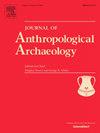Earth construction from past to present: Initial results of the ethnoarchaeological program in the Gobaad Basin (Republic of Djibouti, Dikhil region)
IF 2.2
1区 社会学
Q1 ANTHROPOLOGY
引用次数: 0
Abstract
Architectural studies are of great interest in considering variations in social phenomena. This ethnoarchaeological program therefore focuses on the evolution of building techniques, both in relation to the recent prehistory of Western Asia, and the current context through field surveys carried out in Djibouti. The aim of this article is to present the results of our study conducted in the Gobaad basin (2022–2023) among the Afar and Issa entities by documenting the techniques (materials, layout techniques, morphology of the buildings), referencing practices and socio-cultural context, identifying the networks involved in the dissemination of practices and defining the learning processes in earth construction.
The results of this research show three scenarios. The architectural diversity among the Afar reflect a certain fluidity of social practices, which translates in the architecture into a diverse range of techniques. On the contrary, the standardized architectural traits observed among the the spread of moulded mud brick indicate social compartmentalization and a closed identity. Finally, the adoption by the two communities of an architectural type exogenous to the Gobaad basin allows to formulate a demic diffusion with the adoption of an “Ethiopian style”. These results contribute to our research on the Neolithic of Western Asia by providing socio-cultural, economic and historical interpretations.
从过去到现在的地球构造:戈巴德盆地(吉布提共和国、迪基尔地区)民族考古项目的初步结果
建筑研究对考虑社会现象的变化有着极大的兴趣。因此,这个民族考古项目的重点是建筑技术的演变,既与近代西亚史前史有关,也与通过在吉布提进行的实地调查的当前背景有关。本文的目的是通过记录技术(材料、布局技术、建筑形态)、参考实践和社会文化背景、确定实践传播所涉及的网络以及定义土建的学习过程,来展示我们在Gobaad盆地(2022-2023)对Afar和Issa实体进行的研究结果。这项研究的结果显示了三种情况。阿法尔人的建筑多样性反映了社会实践的一定流动性,这在建筑中转化为各种各样的技术。相反,在模塑泥砖的传播中观察到的标准化建筑特征表明了社会划分和封闭的身份。最后,两个社区对Gobaad盆地外生建筑类型的采用允许通过采用“埃塞俄比亚风格”制定学术扩散。这些结果通过提供社会文化、经济和历史解释,有助于我们对西亚新石器时代的研究。
本文章由计算机程序翻译,如有差异,请以英文原文为准。
求助全文
约1分钟内获得全文
求助全文
来源期刊

Journal of Anthropological Archaeology
Multiple-
CiteScore
4.00
自引率
11.10%
发文量
64
期刊介绍:
An innovative, international publication, the Journal of Anthropological Archaeology is devoted to the development of theory and, in a broad sense, methodology for the systematic and rigorous understanding of the organization, operation, and evolution of human societies. The discipline served by the journal is characterized by its goals and approach, not by geographical or temporal bounds. The data utilized or treated range from the earliest archaeological evidence for the emergence of human culture to historically documented societies and the contemporary observations of the ethnographer, ethnoarchaeologist, sociologist, or geographer. These subjects appear in the journal as examples of cultural organization, operation, and evolution, not as specific historical phenomena.
 求助内容:
求助内容: 应助结果提醒方式:
应助结果提醒方式:


